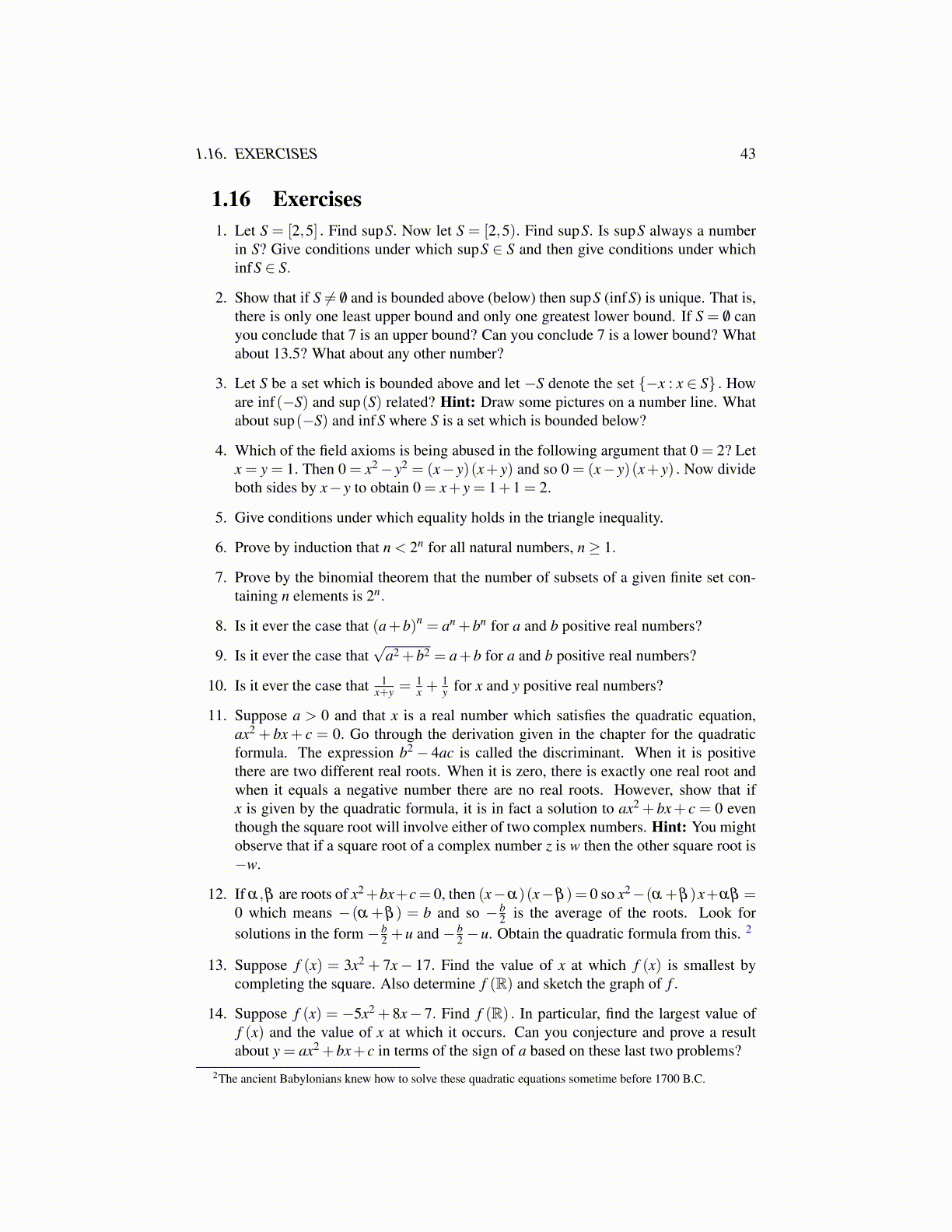
1.16. EXERCISES 43
1.16 Exercises1. Let S = [2,5] . Find supS. Now let S = [2,5). Find supS. Is supS always a number
in S? Give conditions under which supS ∈ S and then give conditions under whichinfS ∈ S.
2. Show that if S ̸= /0 and is bounded above (below) then supS (infS) is unique. That is,there is only one least upper bound and only one greatest lower bound. If S = /0 canyou conclude that 7 is an upper bound? Can you conclude 7 is a lower bound? Whatabout 13.5? What about any other number?
3. Let S be a set which is bounded above and let −S denote the set {−x : x ∈ S} . Howare inf(−S) and sup(S) related? Hint: Draw some pictures on a number line. Whatabout sup(−S) and infS where S is a set which is bounded below?
4. Which of the field axioms is being abused in the following argument that 0 = 2? Letx = y = 1. Then 0 = x2 − y2 = (x− y)(x+ y) and so 0 = (x− y)(x+ y) . Now divideboth sides by x− y to obtain 0 = x+ y = 1+1 = 2.
5. Give conditions under which equality holds in the triangle inequality.
6. Prove by induction that n < 2n for all natural numbers, n ≥ 1.
7. Prove by the binomial theorem that the number of subsets of a given finite set con-taining n elements is 2n.
8. Is it ever the case that (a+b)n = an +bn for a and b positive real numbers?
9. Is it ever the case that√
a2 +b2 = a+b for a and b positive real numbers?
10. Is it ever the case that 1x+y =
1x +
1y for x and y positive real numbers?
11. Suppose a > 0 and that x is a real number which satisfies the quadratic equation,ax2 + bx+ c = 0. Go through the derivation given in the chapter for the quadraticformula. The expression b2 − 4ac is called the discriminant. When it is positivethere are two different real roots. When it is zero, there is exactly one real root andwhen it equals a negative number there are no real roots. However, show that ifx is given by the quadratic formula, it is in fact a solution to ax2 + bx+ c = 0 eventhough the square root will involve either of two complex numbers. Hint: You mightobserve that if a square root of a complex number z is w then the other square root is−w.
12. If α,β are roots of x2+bx+c= 0, then (x−α)(x−β ) = 0 so x2−(α +β )x+αβ =0 which means −(α +β ) = b and so − b
2 is the average of the roots. Look forsolutions in the form − b
2 +u and − b2 −u. Obtain the quadratic formula from this. 2
13. Suppose f (x) = 3x2 + 7x − 17. Find the value of x at which f (x) is smallest bycompleting the square. Also determine f (R) and sketch the graph of f .
14. Suppose f (x) = −5x2 + 8x− 7. Find f (R) . In particular, find the largest value off (x) and the value of x at which it occurs. Can you conjecture and prove a resultabout y = ax2 +bx+ c in terms of the sign of a based on these last two problems?
2The ancient Babylonians knew how to solve these quadratic equations sometime before 1700 B.C.